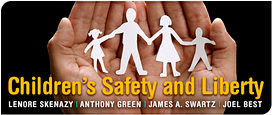As this debate comes to a close, I just wanted to comment on a few things that Ms. Skenazy wrote in her most recent post.
“I Love Safety.” I am thrilled to hear that Ms. Skenazy loves safety, and believes in helmets, car seats and seat belts. I can’t take credit for the “designated texter” idea—that was the Florida Orlando-Orange County Expressway Authority—but I’d be thrilled to work with her to get the awareness out there about the idea. No law, but education about it.
“Accidental Death.” I never used the word “accident” in relation to the scope of the zone of safety with which we are concerned at Safe Kids. It is simply that most unintentional injuries can be prevented, and we should work together to discover and implement strategies to prevent them from happening when feasible.
Heat Stroke vs. Pizza Pick-ups. Laws are not for every case or risk, and in fact laws are reserved for rare cases, pervasive risks, as a last resort. But in some cases laws do work, like with laws requiring bike helmets, car seats, and seat belts. We have determined that the best measure in heat stroke cases is education, just as it was in encouraging parents on best safe sleep practices for kids.
The Imaginary Anti-Lanyard Law. In the Alberta, Canada example about the child injured when he choked on his hall pass lanyard, Ms. Skenazy makes one of her Olympic-qualifying leaps of absurd faith to say that child safety principles would suggest the need for an anti-hall pass law. What I saw is that schools in Alberta temporarily recommended that schools stop using lanyards pending a full investigation. Another leap is Prof. Best’s national 5 mph speed limit. A fundamental weakness of the cases presented by Mr. Best and Ms. Skenazy is that they don’t offer things that really happen, just exaggerations.
Can’t Deny Fate? Bad things are going to happen to good people, no question. Tragedies are going to visit good parents and their children. Fate cannot be outlawed or litigated, but fate can be challenged.
“Not Predictable?” In many cases, we can predict injury. This happens through data collection and a robust sharing of information. Today, we see statistics showing that there’s been a rise in 16- and 17- year-old driver deaths in 25 states, which means more deaths are predictable and public policy should respond—and we have the tools to do so. When we see a rise in pedestrian deaths among teenagers in a Safe Kids Report—possibly caused by distracted walking while smart phone texting—we can predict more incidents and consider ways to reduce them again. That is why I don’t use the word accident, because its definition involves an unforeseen event.
We Have Challenged Fate and Saved Lives. Lots of them in fact. We have successfully gone beyond the things that Ms. Skenazy likes—child seats, seat belts, and helmets. Experiments in graduated driver’s licensing strategies, measures and technology to deal with drunk driving, inexpensive home safety proofing products, safe cribs, and other steps work in a quantifiable way. The inspiration behind the child safety community is that we can beat fate, and we have. The danger is when we surrender to it without a fight.

